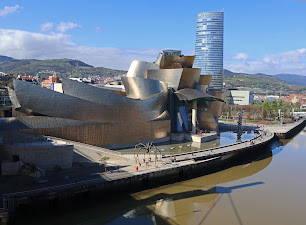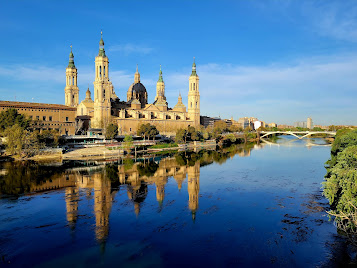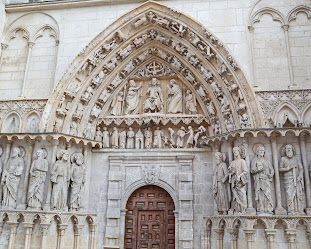A Short Trip through
Northern Spain
Zaragoza, Burgos and Bilbao
Zaragoza, Burgos and Bilbao
March 30 - April 4th, 2023
This is a short blog post about a trip through parts of north-eastern Spain. I met up with my best friend Lara and my godson Max in Barcelona for a few days. Since I had been to Barcelona previously and since I spent most of my time there playing football with Max, this blog post starts in Zaragoza.
Zaragoza
After three days in Barcelona, we took the high-speed train from Barcelona to Zaragoza, where we were joined by Max's dad as well. Spain's AVE high-speed train system is excellent, with very fast and frequent connections between all the major cities. Zaragoza, the capital of the Aragon region and the fifth largest city in Spain, is located in the north-east of the country, about halfway between Barcelona and Madrid. Lara had booked an amazing AirBnB apartment in an old palace right opposite the cathedral. This was the view from the window.
Somewhat unusually, Zaragoza has two cathedrals located right next to each other. The larger and more prominent one of the two is the Cathedral-Basílica de Nuestra Señora del Pilar - a huge and very impressive rectangular building with four elegant towers on each corner. Construction of the mainly Baroque style cathedral happened in several stages and lasted almost 200 years from 1681 to 1872.
Numerous earlier churches had been built at this site by the banks of the river Ebru, since according to legend this is the site where the Apostle Saint James saw an apparition of the Virgin Mary in AD 40, who instructed him to build a church here in her honor. The view of the cathedral from the other side of the Ebro River in the morning light is absolutely stunning.
And the view at night is pretty impressive too.
Zaragoza's second cathedral, the Catedral del Salvador de Zaragoza, also known as La Seo, though not nearly as impressive from the outside, is actually the more important one from an artistic and historical point of the view.
Considered one of the jewels among Spanish cathedrals, it only reveals its true splendor once you are inside. The building includes a number of different architectural styles from different periods. It was built on the site of an Roman forum and incorporates some walls and foundations of a former mosque. Construction started in the 12th century in Romanesque style and continued until the 18th century.
When visiting the cathedral, do not miss the small tapestry museum in the chapter house, which has some incredible and monumental medieval tapestries.
The cathedral is one of the two buildings in Zaragoza, which are part of the UNESCO world heritage site called "Mudejar Architecture of Aragon". Mudejar Architecture is a style specific to this region, that was developed in the 12th century, after the Reconquista, but has significant influences from Arabic art. The second one is the Aljaferia Palace, which is a large medieval fortress started during the second half of the 11th century. The Aljaferia is one of the three major monuments of Spanish-Muslim architecture (the other two are the much more famous Alhambra and the Mosque-Cathedral of Cordoba).
We spent two days in Zaragoza, after which Lara, Gary and Max took the train back to Madrid, while I rented a car and continued my trip driving west towards Burgos. However, there was one important world heritage site along the way, which I couldn't miss.
Monasterio de San Millán
Located in the mountains about half way between Zaragoza and Bilbao lies one of the more remote and lesser known UNESCO world heritage sites of Spain. The Monasterio de San Millán actually consists of two separate complexes: San Millán de Suso - a small Romanesque church in the mountains and San Millán de Yuso - a splendid and richly decorated 16th century monastery in the valley below.
I started at San Millán de Yuso, which was begun to be constructed in the 11th century, because more space was needed due to the increasing number of pilgrims and monks. The current structure mainly stems from the 16th century. You can only visit the interior on a guided tour, which is very interesting and takes you trough the stunning main church with its huge gold decorations, and the beautifully decorated rooms on the upper floors.
Yuso became an influential center of culture, theology, and literature during the Middle Ages. In fact the monastery is known as the birthplace of the Spanish language, as it was here that the first ever scripts were written in Castilian and Basque, instead of Latin.
After the tour of Yuso, I hiked up to San Millán de Suso. There is also a regular shuttle bus that takes you up there, but the hike, though steep, is quite short and well worth it for the views. San Millán de Suso, which consists of a beautiful small Romanesque church, is the much older of the two structures, as it dates back to the 6th century. It was founded on the site where a hermit named Millán, later canonized as Saint Emilianus, lived and performed miracles until 574 AD.
The views of Yuso down in the valley were stunning from up there.
After getting back down to the car park, I continued to drive west for another 1.5 hour to the city of Burgos, in the autonomous region of Castille and Leon.
Burgos
In 1984 Spain was awarded its first ever UNESCO World Heritage dedications. Among the five sites chosen was a cathedral in the small northern town of Burgos, and for good reason. Even among the greatest Gothic churches in Europe, Burgos cathedral stands out as something very special.
When the building was started in 1221, it was the first cathedral in Spain designed in the style of the French Gothic architecture. However, construction lasted over 300 years and it therefore boasts the entire range of Gothic styles culminating in the extraordinary ornate late Gothic central dome.
Throughout the centuries Burgos cathedral has attracted many of the greatest sculptors and architects of the times, who left their mark in the numerous stunning side chapels, huge altar pieces and some of the most beautiful gothic sculptures anywhere, to create this extraordinary masterpiece.
Among the highlights in the interior are the stunning late 16th century golden altar piece of the Capilla Mayor, and the Renaissance Golden Staircase from the 1520s.
The incredibly intricate carvings of the choir stalls were done in two phases in the late 15th and early 16th century.
After spending a couple of hours admiring the cathedral, I walked up to the ruins of Burgos Castle. The earliest foundations of the castle are likely of Roman and Visigoth origin, and the castle was an important stronghold during the middle ages. Napoleon's army completely destroyed the fortifications in 1813 and except for some impressive walls, there is not too much left of the castle itself. But the views over the city and the Cathedral were definitely worth the hike uphill.
The city of Burgos itself is a beautiful, small town. Burgos was a major stop for pilgrims on the way to Santiago de Compostela.The large city square or the 14th century city gate are noteworthy.
The other site not to be missed in Burgos, is the Museum of Human Evolution. Opened in 2010 and housed in a huge open space, the museum has a very good exhibition and houses the remains of the earliest hominids ever found in Europe.
The museum is part of the UNESCO World Heritage site called the "Archaeological Site of Atapuerca", which lies a few kilometers outside of Burgos. The caves of the Sierra de Atapuerca contain one of the richest archeological record of human ancestors in Europe going back more than 1 million years. You can visit the excavation site (but to get a guided tour you have to book in advance), where one of the most important archeological finds in all of Europe was made. The 1.3 million year old jaw bone of a hominid, identified as belonging to a species named Homo Antecessor, has changed our understanding of human evolution in Europe.
Bilbao
After two nights in Burgos, I drove north to the capital of the Basque Region, Bilbao, located on the northern shore of the Iberian peninsula. My first stop there was Spain's only UNESCO world heritage site in the industrial monument category - the Vizcaya Bridge.
Completed in 1893, the 45 meter high steel structure, was the first bridge of its kind in the world, that transported goods and people using a suspended gondola. It was the model for many of these types of bridges built across the world in the late 19th and early 20th century, only a handful of which remain to this day. There are elevators inside the two towers, and you can go up and walk across the narrow and somewhat flimsy seeming metal construction. It is definitely worth it for the views.
The main attraction in Bilbao and the building that really put the city into the global consciousness is the Guggenheim Museum. It was designed by the American architect Frank Gehry and opened to the public in 1997. Since then, it has become one of the most recognizable and iconic modern buildings in the world.
The building is an extraordinary piece of contemporary architecture with its titanium-clad seemingly random shapes. You get the best view of the building from the adjacent bridge, the Puente de la Salve.
In addition to frequent and important temporary exhibitions, the museum boasts an impressive permanent collection of modern and contemporary art, including works by Richard Serra, Jeff Koons and many others.
This is Jeff Koon's flower puppy in the plaza in front of the museum
A few hundred meters upriver from the Guggenheim is another highlight of modern architecture in Bilbao - the curved single-span footbridge, designed by Santiago Calatrava and opened in 1997.
The historical old town of Bilbao, nestled along the banks of the river Nervión, is a busy city center with narrow streets flanked by high townhouses.
There aren't a lot of major sites to see in the city, other than the gothic revival cathedral, but is lively area to walk around full of outdoor cafes and restaurants.
After spending two nights in Bilbao, I flew back to Germany on a direct flight to Munich.

















































No comments:
Post a Comment